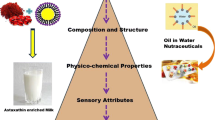Abstract
In the present work, β-carotene nanoemulsions, as potential active ingredients for liquid food, were prepared using high pressure homogenization. The influence of different homogenizing conditions (pressure and number of cycles) and emulsifier type and concentrations on particle size parameters and content of β-carotene was investigated. The droplet size of the emulsions was found to decrease from 416.0 to 97.2 nm with increasing microfluidization pressure, number of cycles, and emulsifier concentration. The optimum conditions for preparing β-carotene nanoemulsions were determined to be homogenization pressure of 120 MPa and 3 cycles. The storage study showed that the nanoemulsions were physically stable for about 5 weeks at room temperature (25°C). β-Carotene degradation was considerably slower in WPI-stabilized nanoemulsions than in Tween 20-stabilized ones, which was attributed to the increased surface area. These results have important consequences for the design and utilization of food-grade nanoemulsions.
Similar content being viewed by others
References
Edge R, McGarvey DJ, Truscott TG. The carotenoids as antioxidants — a review. J. Photochem. Photobiol. B Biol. 41: 189–200 (1997)
Ribeiro HS, Chu BS, Ichikawa S, Nakajima M. Preparation of nanodispersions containing β-carotene by solvent displacement method. Food Hydrocolloid. 22: 12–17 (2008)
Ha DO, Park CU, Kim MJ, Lee JH. Antioxidant and prooxidant activities of β-carotene in accelerated autoxidation and photosensitized model systems. Food Sci. Biotechnol. 21: 607–611 (2012)
Silva HD, Cerqueira MA, Souza BWS, Ribeiro C, Avides MC, Quintas MAC. Nanoemulsions of β-carotene using a high-energy emulsification-evaporation technique. J Food Eng. 102: 130–135 (2011)
McClements DJ, Decker EA, Weiss J. Emulsion-based delivery systems for lipophilic bioactive components. J. Food Sci. 72: R109–R124 (2007)
Moraru CI, Panchapakesan CP, Huang Q, Takjistov P, Liu S, Kokini JI. Nanotechnology: A new frontier in food science. Food Technol. 57: 24–29 (2003)
Tan CP, Nakajima M. β-Carotene nanodispersions: Preparation, characterization and stability evaluation. Food Chem. 92: 661–671 (2005)
Ax K, Mayer-Miebach E, Link B, Schuchmann H, Schubert H. Stability of lycopene in oil-in-water emulsions. Eng. Life Sci. 3: 199–201 (2003)
Jenning V, Schäfer-Korting M, Gohla S. Vitamin A-loaded solid lipid nanoparticles for topical use: Drug release properties. J. Control Release 66: 115–126 (2000)
McClements DJ. Edible nanoemulsions: Fabrication, properties, and functional performance. Soft Matter. 7: 2297–2316 (2011)
Yin LJ, Chu BS, Kobayashi I, Nakajima M. Performance of selected emulsifiers and their combinations in the preparation of β-carotene nanodispersions. Food Hydrocolloid. 23: 1617–1622 (2009)
Triplett M, Rathman J. Optimization of β-carotene loaded solid lipid nanoparticles preparation using a high shear homogenization technique. J. Nanopart Res. 11: 601–614 (2009)
Yuan Y, Gao Y, Zhao J, Mao L. Characterization and stability evaluation of β-carotene nanoemulsions prepared by high pressure homogenization under various emulsifying conditions. Food Res. Int. 41: 61–68 (2008)
Umaporn B, Kwon YJ, Turner M, Bhandari B. Influence of emulsion droplet size on antimicrobial properties. Food Sci. Biotechnol. 20: 793–800 (2011)
Jafari SM, He Y, Bhandari B. Production of sub-micron emulsions by ultrasound and microfluidization techniques. J. Food Eng. 82: 478–488 (2007)
Mao L, Yang J, Xu D, Yuan F, Gao Y. Effects of homogenization models and emulsifiers on the physicochemical properties of β-carotene nanoemulsions. J. Dispers. Sci. Technol. 31: 986–993 (2010)
Pinnamaneni S, Das NG, Das SK. Comparison of oil-in-water emulsions manufactured by microfluidization and homogenization. Pharmazie 58: 554–558 (2003)
McClements DJ. Food Emulsions. Principles, Practices and Techniques. 2nd ed. CRC Press, Boca Raton, FL, USA. pp. 122–146 (2005)
Choi AJ, Kim CJ, Cho YJ, Hwang JK, Kim CT. Effects of surfactants on the formation and stability of capsaicin loaded nanoemulsions. Food Sci. Biotechnol. 18: 1161–1172 (2009)
Surassmo S, Min SG, Bejrapha P, Choi MJ. Effects of surfactants on the physical properties of capsicum oleoresin-loaded nanocapsules formulated through the emulsion-diffusion method. Food Res. Int. 43: 8–17 (2010)
Cornacchia L, Roos YH. Stability of beta-carotene in proteinstabilized oil-in-water delivery systems. J. Agr. Food Chem. 59: 7013–7020 (2011)
Dalgleish DG. Adsorption of protein and the stability of emulsions. Trends Food Sci. Technol. 8: 1–6 (1997)
Floury J, Desrumaux A, Lardières J. Effect of high-pressure homogenization on droplet size distributions and rheological properties of model oil-in-water emulsions. Innov. Food Sci. Emerg. Technol. 1: 127–134 (2000)
Charoen R, Jangchud A, Jangchud K, Harnsilawat T, Naivikul O, McClements DJ. Influence of biopolymer emulsifier type on formation and stability of rice bran oil-in-water emulsions: whey protein, gum arabic, and modified starch. J. Food Sci. 76: E165–E172 (2011)
Gonnet M, Lethuaut L, Boury F. New trends in encapsulation of liposoluble vitamins. J. Control. Release 146: 276–290 (2010)
Lander R, Manger W, Scouloudis M, Ku A, Davis C, Lee A. Gaulin homogenization: A mechanistic study. Biotechnol. Prog. 16: 80–85 (2000)
Dalgleish DG. Food emulsions — their structures and structureforming properties. Food Hydrocolloid. 20: 415–422 (2006)
Sun C, Gunasekaran S, Richards MP. Effect of xanthan gum on physicochemical properties of whey protein isolate stabilized oil-inwater emulsions. Food Hydrocolloid. 21: 555–564 (2007)
Author information
Authors and Affiliations
Corresponding author
Rights and permissions
About this article
Cite this article
Jo, YJ., Kwon, YJ. Characterization of β-carotene nanoemulsions prepared by microfluidization technique. Food Sci Biotechnol 23, 107–113 (2014). https://doi.org/10.1007/s10068-014-0014-7
Received:
Revised:
Accepted:
Published:
Issue Date:
DOI: https://doi.org/10.1007/s10068-014-0014-7




